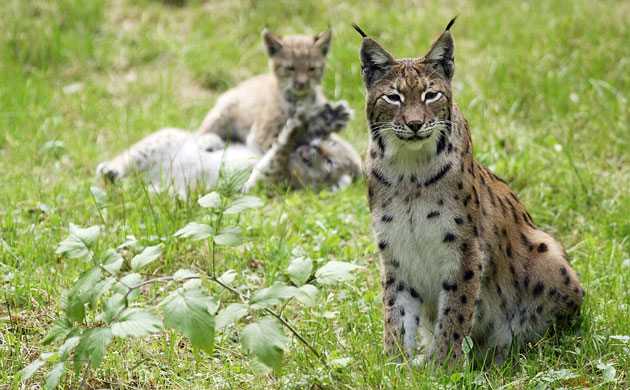TOP STORIES Co-op bans eight pesticides after worldwide beehive collapse
Co-op bans eight pesticides after worldwide beehive collapse
Guardian Unlimited - www.guardian.co.uk
28 Jan 2009
A Benjamin
Photo credit: Miguel Vidal/Reuters
Area: United Kingdom
The Co-op today became the first UK supermarket to ban the use of a group of pesticides implicated in billions of honeybee deaths worldwide. It is prohibiting suppliers of its own-brand fresh produce from using eight pesticides that have been connected to honeybee colony collapse disorder and are already restricted in some parts of Europe. The Co-op said it will eliminate the usage of the neonicotinoid family of chemicals where possible and until they are shown to be safe. The Co-op has over 70,000 acres of land under cultivation in England and Scotland, making it the largest farmer in the UK. Since 2001, it has already prohibited the use of 98 pesticides under its pesticide policy.
Tasmanian devils threatened by contagious cancer
Guardian Unlimited - www.guardian.co.uk
28 Jan 2009
R McGuirk
Area: Tasmania, Australia
The Tasmanian devil, a ferocious, snarling fox-sized marsupial, is in danger of going extinct because of a contagious facial cancer. In the meantime, its biggest rival the European fox is thriving, and may become so dominant that the devil never comes back. Scientists now want to build a double fence standing more than three feet tall to stop the cancer's relentless spread toward the rugged northwest of the island, home to disease-free devils and World Heritage-listed rain forest. Devils spread the cancer when they bite each other during mating or squabble over food. But for any chance of success, the fences would have to be completed within two years, said Hamish McCallum, the senior scientist in the devil rescue program. He predicts the devil will go extinct in the wild within 20 years.
 Virus Could Threaten Lake Champlain
Virus Could Threaten Lake ChamplainWPTZ-TV MSNBC - www.msnbc.msn.com
28 Jan 2009
Area: Lake Champlain, Vermont, USA
A new virus could pose a serious threat to Lake Champlain. Another Disease Threatens Lake Champlain. Viral Hemorrhagic Septicemia, also known as VHS, is killing thousand of fish in the Great Lakes, and federal analysts say fish in Lake Champlain are at high risk of becoming infected. "They've done some evaluation based upon connectivity to other waters, geographic location, likelihood of transient boats, that kind of stuff," said Fisheries Biologist Bernie Pientka. "And Champlain comes in at a high risk."
 Baylor, Houston Zoo team up to fight lethal elephant virus
Baylor, Houston Zoo team up to fight lethal elephant virusHouston Chronicle - www.chron.com
28 Jan 2009
B Murray
Photo credit: Karen Warren
Area: Houston, Texas, USA
Baylor College of Medicine and the Houston Zoo will join forces to try to develop a vaccine for a herpes virus that has killed six young Asian elephants born at the zoo and could leave zoos worldwide without enough of the popular animals for exhibition in coming decades. The Baylor-Houston Zoo team will try to learn how the virus is transmitted and becomes fatal, said Alan Herron, a veterinarian who directs Baylor’s Comparative Pathology Laboratory and whose specialities include comparing animal and human diseases. A vaccine will require much work. Researchers must discover how to grow the virus so vaccines and medications that might lessen its deadliness can be tested, Herron said. But a vaccine or partial vaccine is the ultimate goal.
 Dwindling NZ frog species tipped to make a comeback
Dwindling NZ frog species tipped to make a comebackSouthland Times - www.stuff.co.nz/southlandtimes
29 Jan 2009
Photo credit: Barry Harcourt
Area: New Zealand
Global frog numbers have been in decline both because of environmental factors and a deadly disease identified as chytrid fungus (Batrachochytrium dendrobatidis). This disease was first detected in New Zealand in 1999 in an exotic frog population in Canterbury. In Southland, there are no known native frogs but, according to frog researchers, introduced frogs to the region have been in decline for about five years. Natural historian Lloyd Esler said green frogs (golden bell frogs) used to be common in and around Invercargill but he had not sighted one for years.
OTHER WILDLIFE HEALTH RELATED NEWS
Photo courtesy: Guardian Unlimited - www.guardian.co.uk
 Pictured: Comeback contenders: The species being reintroduced to the British countryside
Pictured: Comeback contenders: The species being reintroduced to the British countryside- Penn study identifies how ebola virus avoids the immune system
- Butterflies Across Europe Face Crisis As Climate Change Looms
- Conservationists say wave turbines could impact wildlife [Scotland]
- Trumpeter swans decide to stick around for the winter [Minnesota]
- Wildlife Experts Concerned Over Pelican Plight [Florida]
- H5N1: Avian Influenza

- Whatcom County birds to be tested for avian flu [Washington]
- Avian influenza – situation in China - update 3
- Avian influenza - situation in Egypt - update 2
- Indonesian woman dies of suspected bird flu: doctor
WILDLIFE HEALTH RELATED PUBLICATIONS
Origin and Biology of Simian Immunodeficiency Virus in Wild-Living Western Gorillas
Journal of Virology. 2009 Feb; 83(4): 1635-1648
J Takehisa et al.
Practical considerations for high-throughput influenza A virus surveillance studies in wild birds using molecular diagnostic tests
J Clin Microbiol. 2008 Dec 24. [online abstract only]
VJ Munster et al.
Prion sequence polymorphisms and chronic wasting disease resistance in Illinois white-tailed deer (Odocoileus virginianus)
Prion. 2008 Jan;2(1):28-36. Epub 2008 Jan 20 [online abstract only]
AC Kelly et al.





No comments:
Post a Comment